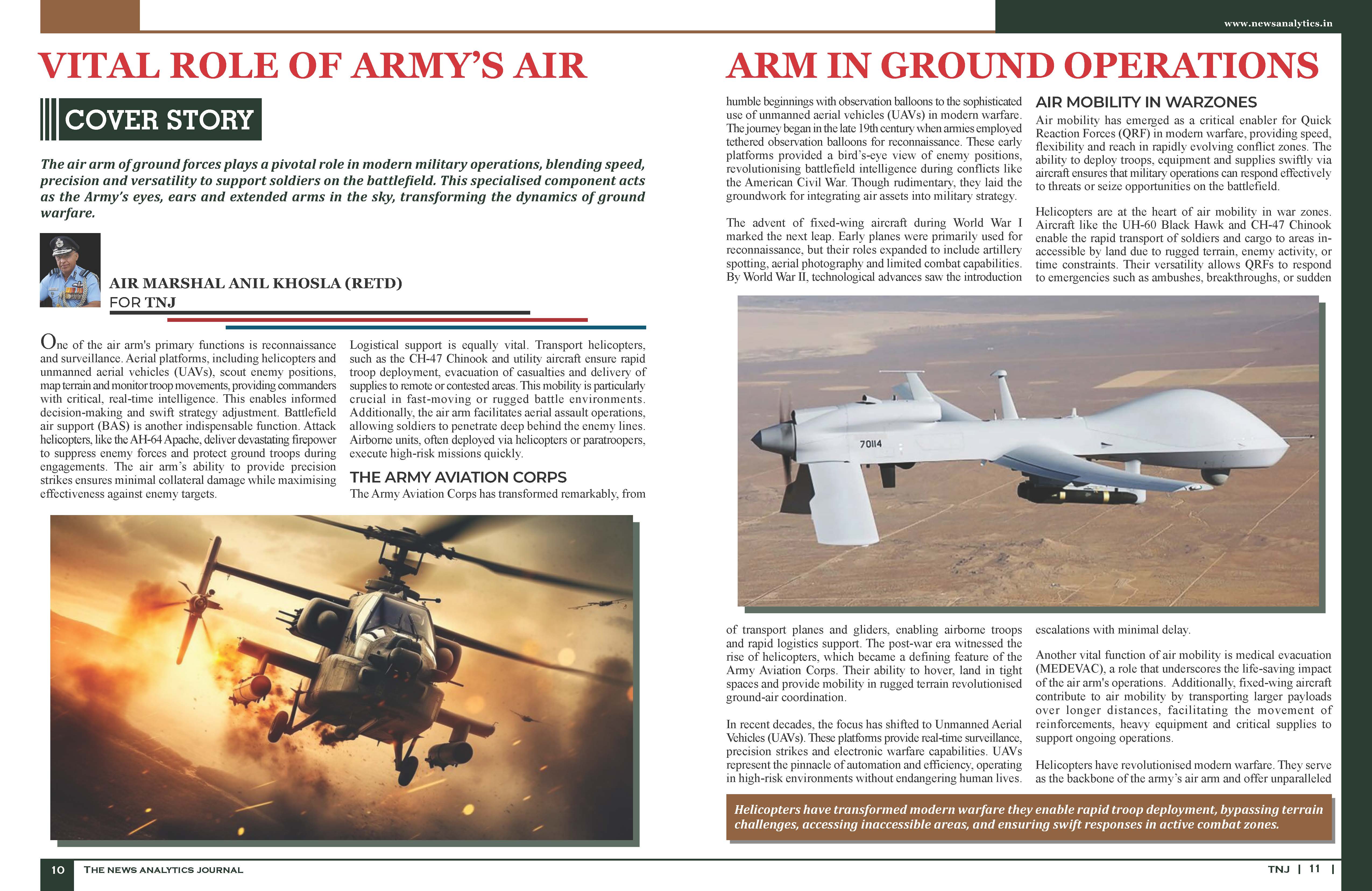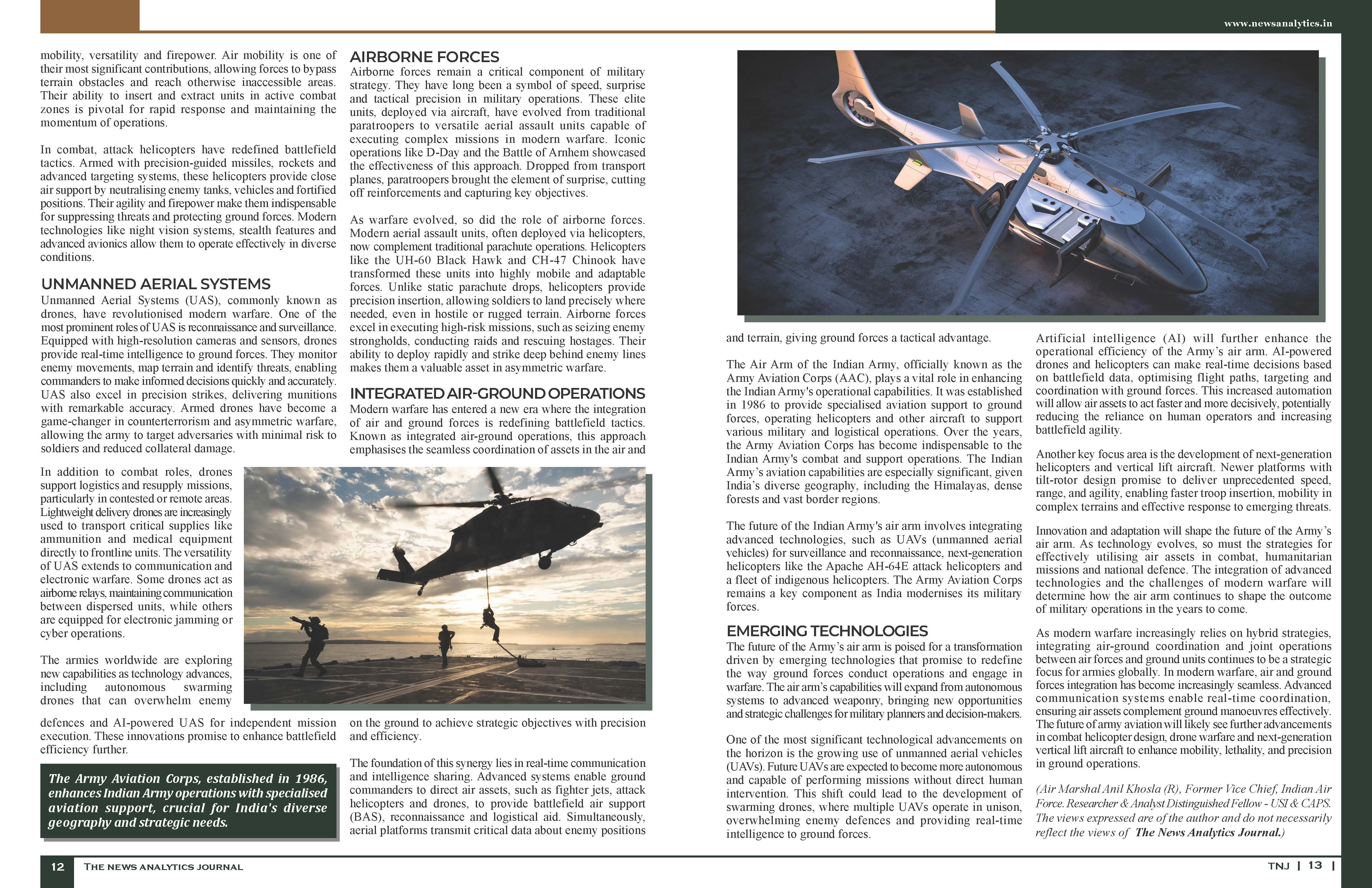
Pic Courtesy Net
Combat drones, also known as unmanned aerial vehicles (UAVs), have revolutionised modern warfare by providing advanced capabilities for surveillance, intelligence gathering, and precision strikes. These drones are utilised by militaries worldwide, ranging from the United States MQ-9 Reaper to China’s CH-4 and Russia’s Forpost. Their ability to operate in hostile environments without risking human lives has made them invaluable in counterterrorism, border patrol, and intelligence operations. Drones are equipped with advanced sensors, cameras, and weapons systems, enabling real-time data transmission and the ability to carry out airstrikes accurately. The global proliferation of combat drones has led to their adoption by a growing number of nations, each leveraging them for strategic advantages in conventional and asymmetric conflicts. As their technology evolves, drones become more autonomous, with artificial intelligence and machine learning improving operational efficiency. However, the widespread use of combat drones raises ethical concerns, particularly regarding civilian casualties, accountability, and the potential for misuse in geopolitical conflicts. The future of combat drones will likely see further advancements in stealth, range, and lethality, making them an integral part of military strategies worldwide and sparking ongoing debates about their regulation and impact on international law.
USA
MQ-9 Reaper. The MQ-9 Reaper, a long-endurance, high-altitude UAV, stands out in the U.S. Air Force’s arsenal. Its ability to carry precision-guided munitions such as Hellfire missiles and GBU-12 bombs makes it a formidable force in strike missions. The Reaper’s extensive use in counterterrorism operations and ISR roles, an impressive range of over 1,800 km, and flight endurance of 27 hours solidify its position as a key asset in modern warfare.
RQ-170 Sentinel. The RQ-170 Sentinel is a stealth reconnaissance UAV used by the U.S. Air Force. Its flying-wing design is optimised for stealth and high-altitude operations. The Sentinel is known for its involvement in high-profile missions, including surveillance operations over Iran and Pakistan.
MQ-1C Gray Eagle. The MQ-1C Gray Eagle is an upgraded variant of the Predator drone used by the U.S. Army. It provides extended endurance, advanced ISR capabilities, and the ability to deploy Hellfire missiles and precision bombs. With an endurance of 25 hours and real-time data relay, the Gray Eagle plays a vital role in counterinsurgency and tactical battlefield support.
XQ-58A Valkyrie. The XQ-58A Valkyrie is a low-cost, stealthy unmanned combat aerial vehicle (UCAV) designed to operate alongside manned fighter jets in a “loyal wingman” role. Developed by Kratos for the U.S. Air Force, offers autonomous operations, long-range capabilities, and potential for strike missions with minimal radar detectability.
RQ-4 Global Hawk. The RQ-4 Global Hawk is a high-altitude, long-endurance surveillance drone used primarily for intelligence, surveillance, and reconnaissance (ISR) missions. Operated by the U.S. Air Force and NATO, it provides real-time battlefield awareness. Some variants, such as the MQ-4C Triton, feature limited weapon-carrying capabilities for defensive purposes.
MQ-25 Stingray. The MQ-25 Stingray is a carrier-based drone designed to provide aerial refuelling for U.S. Navy aircraft, extending their range and operational endurance. Built by Boeing, it also has secondary intelligence, surveillance, and reconnaissance (ISR) capabilities, with potential for future combat roles such as electronic warfare or precision strikes.
RQ-180. The RQ-180 is a secretive, high-altitude stealth reconnaissance drone believed to provide deep-penetration ISR capabilities in contested airspace. Developed for the U.S. Air Force, it likely features advanced radar evasion technologies and long endurance. Rumours suggest it could possess limited strike capabilities, complementing traditional reconnaissance missions with potential offensive roles.
Switchblade (USA). The Switchblade is a compact, loitering munition developed by AeroVironment, designed for rapid deployment in tactical operations. It provides precision strike capabilities with real-time intelligence and can be launched from a portable platform. Switchblade is ideal for anti-armour and high-value target missions, offering flexibility in diverse combat scenarios.
China
Wing Loong II. The Wing Loong II is a combat UAV developed by China for long-endurance missions. Similar to the American MQ-9 Reaper, it carries a variety of air-to-ground weapons, including precision-guided bombs and missiles. It has a maximum endurance of 20 hours and an operational range exceeding 1,000 km. The Wing Loong series has been widely exported to countries in Africa and the Middle East.
CH-5 Rainbow. The CH-5 is a heavy-class combat drone developed by China, resembling the MQ-9 Reaper in design and functionality. It can carry up to 16 missiles and has an endurance of 36 hours, making it suitable for long-duration strike and reconnaissance missions. Its advanced sensors and electronic warfare capabilities allow it to conduct surveillance and combat operations efficiently.
GJ-11 Sharp Sword. The GJ-11, known as Sharp Sword, is a stealth UCAV designed for high-end combat operations. Its flying-wing design optimises it for low observability and precision strikes. It is expected to play a significant role in China’s future airpower, particularly in contested environments with anti-access/area-denial threats.
WZ-7 Soaring Dragon. The WZ-7 Soaring Dragon is a high-altitude surveillance drone developed by China. It is designed for reconnaissance and intelligence gathering in contested airspaces. With its stealth features, it is capable of long-endurance missions and may also have potential for combat roles, making it a versatile asset for modern military operations.
FH-97. The FH-97 is a loyal wingman drone designed to work alongside manned fighter jets in China’s air force. It offers advanced autonomy and long-range capabilities, assisting in tasks like surveillance, strike missions, and electronic warfare, thereby enhancing the capabilities of its human counterparts in both offensive and defensive operations.
CH-7. The CH-7 is a Chinese stealth unmanned combat aerial vehicle (UCAV) designed for high-altitude, long-endurance missions. With radar-evading technology, it is built for deep penetration strikes in heavily defended airspace. Its capabilities include precision attacks and reconnaissance, positioning it as a key component in China’s modernised military strategy.
Russia
S-70 Okhotnik-B (Russia). The S-70 Okhotnik-B, or “Hunter-B,” is a stealth UCAV designed to operate alongside Russia’s Su-57 fighter jets. It features advanced stealth capabilities, a flying-wing design, and the ability to carry a significant payload of precision-guided munitions. With a range of over 6,000 km and autonomous combat capabilities, the Okhotnik-B represents Russia’s push toward integrating AI into warfare.
Orion (Russia). The Orion UAV is a MALE combat drone developed by Russia with capabilities similar to those of the MQ-1 Predator. It can last 24 hours and carry guided munitions such as KAB-20 bombs and Vikhr missiles. The Orion has been deployed in Syria and Ukraine for reconnaissance and precision strikes, showcasing Russia’s advancements in drone warfare.
KUB-BLA. The KUB-BLA is a loitering munition (suicide drone) developed by Russia. Designed to deliver precision strikes, it flies autonomously to target specific assets and detonates on impact. It is a low-cost, effective weapon for disabling high-value targets, particularly in conflict zones with limited anti-aircraft defences.
Lancet. The Lancet is a lightweight loitering munition used in the Ukraine conflict, providing precise, targeted strikes. It is designed to fly autonomously, locate and identify targets, and detonate on impact. Its compact size, ease of deployment, and versatility make it an effective weapon against stationary and moving targets.
Altius-U. The Altius-U is a long-range, unmanned aerial system (UAS) designed for intelligence, surveillance, reconnaissance (ISR), and strike missions. Developed by Russia, it features advanced avionics and can carry a range of payloads, including precision-guided munitions. Its capabilities make it a valuable asset for deep reconnaissance and tactical airstrikes.
ZALA Lancet (Russia). The ZALA Lancet is a Russian tactical loitering munition designed for precision strikes against high-value targets. It is equipped with advanced sensors for target acquisition and can carry warheads to destroy enemy assets. The Lancet is used for anti-armour, anti-aircraft, and anti-personnel missions, effectively supporting battlefield operations.
Israel
Harop (Israel). The Harop is a loitering munition UAV designed to hunt and destroy radar installations and high-value targets autonomously. It has an operational range of 1,000 km and carries an explosive payload to engage targets with high precision. Widely used by Israel and other nations, the Harop is a key asset in electronic warfare and counter-air defence roles.
Hermes 900 (Israel). The Hermes 900 is a MALE UAV used primarily for ISR and strike operations. It boasts a long endurance of up to 36 hours and can carry precision-guided munitions. Several countries use the drone for border surveillance, counterterrorism, and maritime patrol missions. Its modular design allows for different payloads, including SIGINT and EO/IR sensors.
Heron TP (Eitan). The Heron TP, also known as Eitan, is a strategic, long-endurance UAV developed by Israel Aerospace Industries (IAI). It boasts significant strike capabilities with a range of over 1,000 km and can carry a variety of payloads, including precision-guided munitions. This UAV is primarily used for surveillance and targeted strikes.
Harpy. The Harpy is an advanced anti-radar loitering munition developed by IAI. It is designed to seek and destroy radar systems by autonomously detecting, targeting, and attacking them. The Harpy’s loitering capability allows it to remain in an area, waiting for radar signals to attack, making it a critical tool for suppressing enemy air defences.
IAI Ghost. The IAI Ghost is a small, tactical UAV designed for special operations and precision strikes. Its lightweight and compact design allows for easy deployment in covert missions. It can carry out targeted strikes on enemy assets while offering real-time intelligence and surveillance, which is ideal for intelligence collection and rapid response scenarios.
Turkey
Bayraktar TB2 (Turkey). The Bayraktar TB2 is a MALE (Medium-Altitude, Long-Endurance) drone known for its success in recent conflicts in Libya, Syria, and Ukraine. It is equipped with laser-guided smart munitions and advanced surveillance capabilities. With an endurance of 27 hours and an operational range of 150 km, the TB2 provides cost-effective strike and reconnaissance solutions. Its impact on asymmetric warfare has made it popular with several countries.
Akinci (Turkey). Turkey’s advanced HALE (High-Altitude, Long-Endurance) UAV, the Akinci, is a strategic asset with its sophisticated avionics and AI-driven capabilities. Its ability to carry a variety of smart munitions, including air-to-ground missiles and standoff weapons, combined with an endurance of 24 hours and high-altitude operation, underscores its strategic role in Turkey’s defence doctrine.
Kızılelma (Turkey). The Kızılelma is a jet-powered stealth UCAV designed for high-speed strike missions. As Turkey’s first combat drone with air-to-air capabilities, it integrates AI-assisted targeting and electronic warfare capabilities. The Kızılelma is expected to play a significant role in future air combat operations, complementing Turkey’s manned fighter fleet.
Anka-S. Turkish Aerospace Industries (TAI) developed the Anka-S, an advanced UAV with additional strike capabilities, for intelligence, surveillance, and reconnaissance (ISR) missions. It can operate at high altitudes and extended durations and is equipped with advanced sensors and precision-guided munitions, making it practical for surveillance and targeted strikes.
Iran
Shahed-136 (Iran). The Shahed-136 is a loitering munition drone, often referred to as a ‘suicide drone,’ extensively used in asymmetric warfare. With its range of over 2,500 km and an explosive warhead designed to target critical infrastructure and military assets, the Shahed-136 has been deployed in conflicts in the West Asia and Ukraine, showcasing Iran’s growing drone capabilities.
Shahed-129. The Shahed-129 is an Iranian-developed UAV designed for ISR and strike missions, widely used in the West Asia. With a range of over 2,000 km, it can carry precision-guided munitions and is primarily deployed for reconnaissance, surveillance, and targeted strikes, supporting military operations in conflict zones.
Mohajer-6. Iran developed the Mohajer-6, a multi-role UAV capable of ISR and combat operations. Equipped with guided munitions, it can conduct precise airstrikes while gathering real-time intelligence. Its versatility makes it effective for various military tasks, including surveillance and targeted operations in diverse environments.
Karrar. The Karrar is a jet-powered combat UAV developed by Iran. It is designed for high-speed, long-range strike missions. It features advanced avionics and can carry a variety of weapons, making it suitable for precision airstrikes and tactical operations. Its jet propulsion allows for rapid deployment and high-performance capabilities.
India
Rustom-II (India). Rustom-II, known as TAPAS-BH-201, is India’s indigenous MALE UAV designed for surveillance and strike missions. It features an endurance of 24 hours and a payload capacity of 350 kg, including advanced surveillance systems and guided munitions. Developed by DRDO, the drone aims to reduce India’s dependence on imported UAVs and enhance its reconnaissance capabilities.
Ghatak (UCAV project). The Ghatak is an Indian stealth UCAV (Unmanned Combat Aerial Vehicle) currently under development by DRDO. It is designed for high-precision strike capabilities, features advanced stealth technology, and has low radar visibility. It is intended for deep penetration missions and aims to enhance India’s strategic capabilities in unmanned warfare.
Archer-NG. The Archer-NG is an advanced armed variant of the Rustom UAV, currently under development by India’s DRDO. It is designed to carry a variety of payloads, including precision-guided munitions, to conduct airstrikes. The Archer-NG enhances India’s tactical capabilities, providing a versatile surveillance, reconnaissance, and offensive operations platform.
European Union (Various Countries)
Taranis (UK). BAE Systems developed the Taranis, a stealth combat UAV designed for deep penetration strike missions. It features advanced stealth, high-speed capabilities, and autonomous flight operations. As a demonstrator for future UCAV technology, the Taranis highlights the UK’s focus on developing next-generation unmanned systems.
Eurodrone (Europe). The Eurodrone is a collaborative project by Germany, France, Italy, and Spain to develop a MALE UAV with European autonomy. It is intended for ISR and precision strike roles with a payload capacity supporting various sensors and munitions. The Eurodrone aims to reduce Europe’s reliance on foreign drone technology.
Neuron. The Neuron is a French/European stealth UCAV prototype developed by Dassault Aviation. It features advanced stealth technology for precision strike missions to minimise radar detection and enhance survivability in hostile environments. The Neuron serves as a testbed for future unmanned combat systems, showcasing European capabilities in unmanned aerial warfare.
South Korea
KUS-FS. The KUS-FS is a South Korean MALE UAV designed for intelligence, surveillance, and reconnaissance (ISR) and strike missions. Its advanced avionics and long endurance allow it to carry precision-guided munitions, effectively supporting military operations. Its multi-role capability makes it a versatile asset for both surveillance and combat.
KUS-VH. The KUS-VH is a South Korean loyal wingman concept currently under development. It is designed to operate alongside manned aircraft. It can perform autonomous missions, supporting reconnaissance, strike, and electronic warfare. The KUS-VH aims to enhance the capabilities of piloted platforms by acting as a cooperative and agile aerial teammate.
Pakistan
Burraq. The Burraq is an Indigenous UCAV developed by Pakistan and modelled after Chinese UAV designs. It is primarily used for surveillance and strike missions and can carry precision-guided munitions. The Burraq provides Pakistan with a versatile platform for targeting enemy assets and conducting reconnaissance in hostile environments.
Shahpar-II. The Shahpar-II is a Pakistani ISR and combat drone designed for intelligence gathering and precision strike missions. Equipped with advanced sensors and guided munitions, it can conduct surveillance while engaging enemy targets with high accuracy. The Shahpar-II offers enhanced operational flexibility, serving both reconnaissance and offensive roles in military operations.
Other Notable Drones
MQ-28 Ghost Bat (Australia). The MQ-28 Ghost Bat is an Australian loyal wingman drone developed for the Royal Australian Air Force (RAAF). It is designed to operate autonomously alongside manned aircraft, enhancing their surveillance, combat, and electronic warfare capabilities. The Ghost Bat provides flexible, cost-effective support in complex air operations.
CH-4 (Iraq/Jordan/Algeria imports). The CH-4 is a Chinese-built MALE UCAV widely exported to Iraq, Jordan, and Algeria. It is designed for long-endurance ISR missions and precision strikes. Equipped with advanced sensors and guided munitions, the CH-4 provides an effective platform for surveillance and targeted airstrikes in varied operational environments.
Warmate (Poland). The Warmate is a Polish-made tactical loitering munition designed for ISR and precision strike missions. It is lightweight and can be deployed in combat, including anti-armour operations. The Warmate can carry explosives to engage enemy targets, offering a cost-effective and versatile solution for tactical warfare.
Please do Comment.
For regular updates, please register your email here:-
References and credits
To all the online sites and channels.
Disclaimer:
Information and data included in the blog are for educational & non-commercial purposes only and have been carefully adapted, excerpted, or edited from reliable and accurate sources. All copyrighted material belongs to respective owners and is provided only for wider dissemination.



